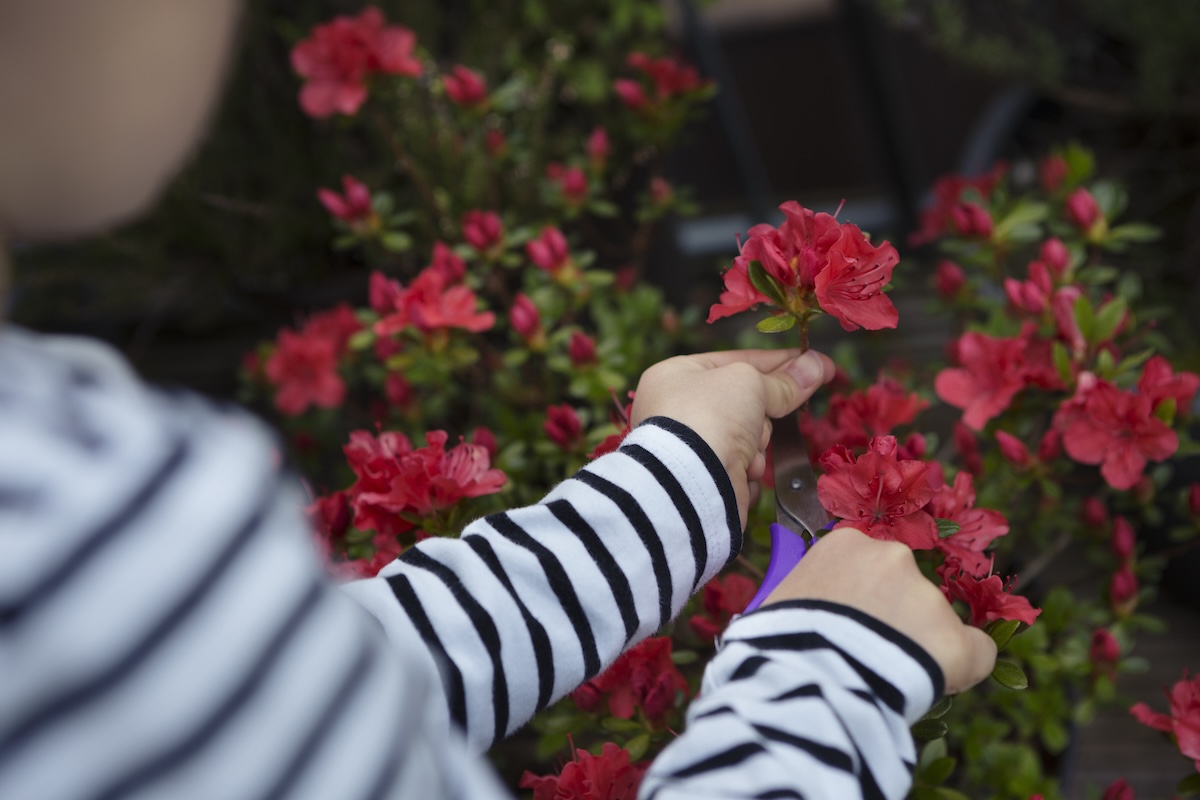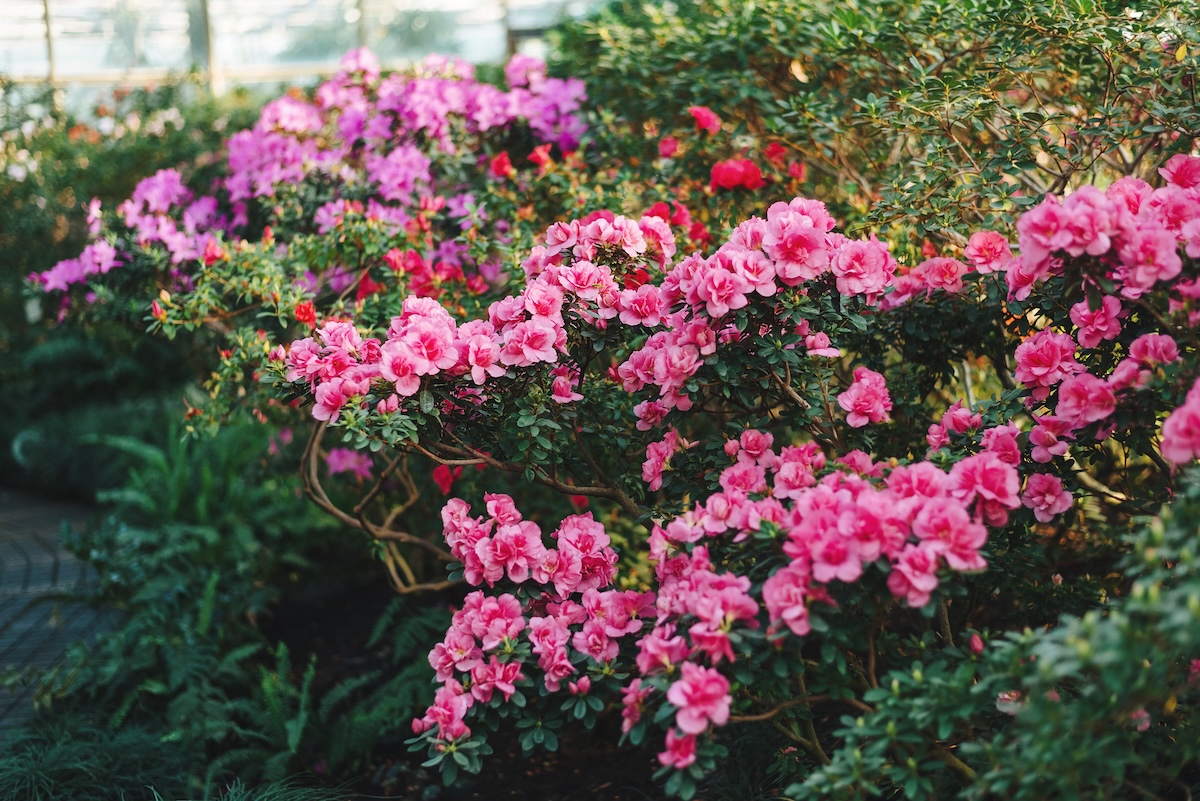

We may earn revenue from the products available on this page and participate in affiliate programs. Learn More ›
When considering how to prune azaleas, take into account that such pruning isn’t actually a necessity unless your bushes have outgrown their allotted space. You can prevent that by planting azaleas where there is plenty of room for them to mature and by choosing dwarf azaleas for locations beneath windows.
Selecting a site where the bushes receive some sun, preferably in the morning, will also help keep azalea compact without pruning. Caring for azaleas, among whose variety of colors you can find the perfect shade for your monochromatic garden, isn’t difficult unless you make it so.
When to Prune Azaleas
When to prune azaleas depends on whether your bushes need routine pruning or a drastic cutting back. Azalea maintenance pruning should be performed just after the plant has finished flowering, which can vary from late winter to early summer, depending on the cultivar and climate. Don’t prune after the beginning of July, which is when the plant will start making new buds for the following year.
However, if you intend to cut an azalea back severely, do so in early spring before its growth begins. Resign yourself to sacrificing that year’s flowers; the early start will remove this year’s buds but give the bush time to recover to form buds for the following year.

Before You Begin
Before you begin pruning your azalea bushes, clean the blades of your pruning shears and pruning loppers with rubbing alcohol. It’s a good idea to clean them again between each bush to avoid spreading disease from one to another.
For healthy bushes, opt for thinning rather than heading cuts.
Because some azaleas are evergreen, gardeners occasionally shape them into formal balls or hedges. PennState Extension warns against this practice as “heading cuts result in a profusion of growth below the cut that creates a wall of growth on the outside of the shrub that blocks sun from the interior of the shrub and impedes air circulation.”
The University of Georgia Extension advises that, “Thinning is the preferred pruning technique because it opens up the canopy, improves air flow and helps minimize diseases. It also results in a more natural growth form than heading and requires less routine maintenance.”
For rejuvenation, cut your azalea back severely in early spring.
If you want to start over again with an old azalea that routine pruning won’t help, try cutting it back to within 6 to 12 inches from the ground in early spring. Once it begins putting out new growth, wait until those shoots are 6 to 12 inches tall before snipping off their tips to force the plant to bush out. Make sure you keep it well watered but avoid applying fertilizer during what will be a stressful time for your azalea.

For thinning, remove damaged, diseased, or protruding branches after bloom.
If your azalea doesn’t require such drastic measures but could use a little thinning to allow light to penetrate to its interior, wait until after the plant blooms to remove any damaged, diseased, or protruding branches. Cut each one all the way back to just above another branch or just above the plant’s trunk.
Instead of using hedge shears on your plants to create what it calls “meatballs in the landscape,” University of Arkansas Extension recommends that you “selectively thin at staggering heights throughout the bushes. This will give you a more full, natural look and more flowers next spring.”
Prune reblooming azaleas after their spring flush, not in autumn.
Because reblooming azaleas such as the Encore series make buds whenever they make new growth, you’ll want to prune them after their first flush of flowers in spring to encourage them to make plenty of new buds for summer and fall. However, you should avoid pruning them after the fall flush—or at any time during the 2 months before the date when your first fall frost usually occurs. That will help prevent any tender new growth from occurring too late in the season.
Use your azalea clippings to propagate new azaleas for free.

You can use clippings from your pruning for propagating azaleas if you like. As to how to propagate azaleas, University of Arkansas Extension recommends that you select 3- to 4-inch cuttings and remove the leaves from the lower half of each stem. Then dip the bottom ½ inch of each cutting in rooting hormone and pot up the cuttings in damp peat moss.
Enclose the pot in a closed plastic bag supported above the cuttings with crossed arching wires. Place the pot in a shaded location and check the cuttings for rooting after 3 weeks or so.
Final Thoughts
To sum up, if you choose your locations carefully when planting azalea plants, you shouldn’t need to prune the bushes at all. The types of azaleas you select also can make a difference as deciduous varieties are more likely to grow gawky than evergreen ones are. If you must trim the bushes, do that immediately after they flower. At all costs, avoid late summer pruning, which is liable to remove all the buds that otherwise should bloom the following year. In other words, you don’t want to make care for azalea bushes (AKA rhododendron care) any more stressful than necessary.
